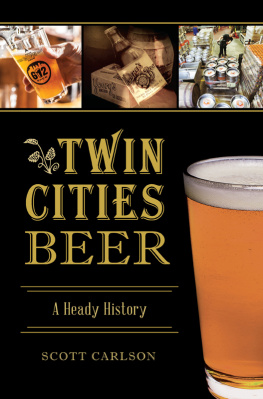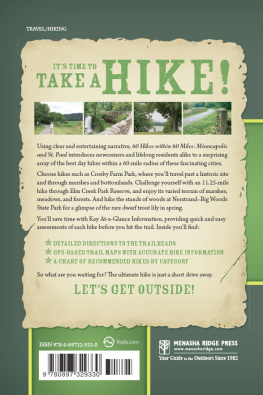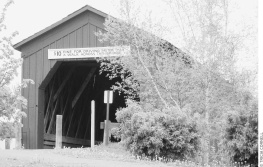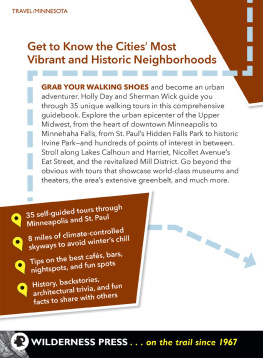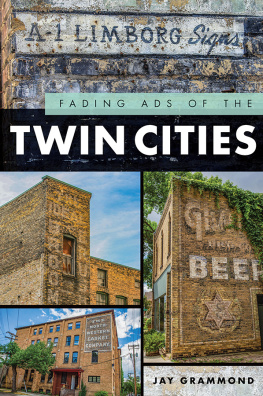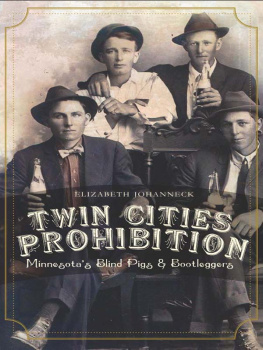Twin Cities
UNCOVERED
The Arthurs

Library of Congress Cataloging-in-Publication Data
Arthur, Lindsay G., 1917
Twin Cities uncovered / The Arthur Family : [written by] Lindsay G. Arthur and Jean Arthur.
p. cm.
Includes Index
ISBN: 978-1-55622-388-4
1. Minneapolis (Minn.)Description and travel. 2. Saint Paul (Minn.)--Description and travel. I. Arthur, Jean. II. Title.
F614.M6A77 1995
917.765790453--dc20
94-48650
CIP
Copyright 1996, The Arthurs
All Rights Reserved
Seaside Press is an imprint of Wordware Publishing, Inc.
No part of this book may be reproduced in any form or by any means without permission in writing from Wordware Publishing, Inc.
Printed in the United States of America
10 9 8 7 6 5 4 3 2 1
9512
All inquiries for volume purchases of this book should be addressed to Wordware Publishing, Inc., at 1506 Capital Avenue, Plano, Texas 75074. Telephone inquiries may be made by calling:
(214) 423-0090
Contents
Preface
Most readers will know some of the people and places and data set forth here. Some readers will know many of them, maybe most of them. Hopefully no one will know them all. Maybe there will be some new fact, some new anecdote or rumor or legend that will titillate and maybe evoke a smile or pique the readers curiosity.
Most everyone will find corrections; some will be right. To have checked out every fact and every statement would have been a task of years, and then the earlier information might have changed. This tome is not intended for professional researchers and does not meet their standards of accuracy. It is intended to show the wonders of our community. Its goal is to pull people off of their couches and out of their chairs to go out and see and sample the full life in this the best of all communities.
This book is intended to entice readers to visit places of interest, places of fun, places of yesterday, and places of tomorrow. Some of the places are awesome, in the preadolescent meaning of the word. Many are inspirational. A lot of them will bring smiles. Some of them may send you out to find out more. All of them are interesting.
There are no doubt places and people missed; this is a large community. Whole categories, such a restaurants, are omitted because of their transient nature or because there are so many of quality that, like churches, to mention one would require in fairness mentioning all. Even a bibliography is omitted; there are so many books about the area, some with overwhelming photography. Libraries will gladly make these available.
Most importantly, this is a book to be enjoyed more than studied, to bring home to readers that this is in fact about the best place in the whole world in which to live.
The Father of Waters
The Mississippi was known to the Ojibwa who had lived near it for a millenium as mis-sipi, or Great River. And great it is! It is truly the Father of Waters.
It defines the Twin Cities. For most of their beginning it was their umbilical cord, bringing in their needs and supplies, taking out their grain and their furs and their lumber, supplying their water and the power for sawing their seemingly endless timber and grinding their grain, supplying magnificent views of flowing waters, and giving the inspiration of a roaring falls.
It begins in Itasca, which is a Latin, not an Indian, name. Henry Schoolcraft, the Indian Commissioner in 1832, first proved that he had found the rivers true head at Itasca, in Latin veritas caput (verITAS CAput). There is a large and beautiful park there now with a place where you can walk across the Mississippi River in one step. Then it flows south 2,348 miles to New Orleans, gaining strength from the Ohio and the Missouri and dozens of other tributaries to become the worlds mightiest river.
Seventy-two miles of the river as it flows through the Twin Cities is recognized as a National Waterway. Minneapolis is a coined name from the Ojibwa minne for water and the Greek polis for city. Saint Paul was originally named Pigs Eye for Pierre Parrant, a booming, colorful, one-eyed French fur trader who opened the first saloon on the Upper Mississippi. It became so popular that you could address a letter to someone at Pigs Eye and it got there. Some years later, Father Galtier persuaded the powers that were that Saint Paul would be more dignified. In gratitude, St. Paul city leaders named a plaza after the good father. A down-river island used for a sewage plant was named for Pigs Eye, as was a beer which has become a national favorite.
The National Waterway section begins at Dayton, a town that until about two generations ago preserved much of its French language and way of life. The section ends at Hastings, a city spread along the narrow edge of the river with so little room for the western end of a bridge over the river that the approach ramp was a high spiral. The bridge has since been replaced by a less colorful span. In the seventy-two miles of its passage, it picks up the waters of the Crow River at Dayton, the Rum River at Anoka, the Minnesota River at Fort Snelling, and the St. Croix River at Hastings, plus numerous creeks.
In between there are about 2.5 million people in the Twin Cities. Theyre not really twins. St. Paul is older, more settled, Irish and Italian, predominantly Catholic. Minneapolis boasts of its newness, its aggressiveness; it is Scandinavian, German, Polish, predominantly Protestant. The two cities have been competitors since they began, but now, when they are outnumbered by their suburbs, they are working more closely together.
Near the northwestern corner of the metropolitan area, at Coon Rapids, up by Anoka, a dam was built to generate electrical power. The dam covered up the rapids and backed up the river almost to the Crow, making it like a long lake.
Cities are built beside rivers and streams. Big cities are built beside large rivers. Some big cities are built beside large rivers with interesting islands. Minneapolis has a big river; the river has islands: Boom Island and Nicollet Island. But Minneapolis also has falls, large falls, the only major city in the world so beautifully and usefully sited. Yet for at least a century, the downtown of Minneapolis turned its back on its river. St. Paul did it better, it has always faced the river. And now St. Paul is doing it even better: in September 1994, the St. Paul Chamber Orchestra played a concert on a barge moored in the river to an audience of over 8,000 sitting on the grass on Navy Island. Not only did they attract a much larger audience than expected, they did it playing only the classics: Handel, Beethoven, Rossini, and Mozart.
For a century or so, in the center of Minneapolis at water level there were railroad tracks and switching yards, coal dumps, and a lot of weeds and brush. Railroad depots, grain elevators, and warehouses dominated the bluffsall the ingredients of the industry that built the city. You could see the river from a bridge as you crossed, but that was about the only place it could be seen. All that has changed. It is now called the Mississippi Mile.
The Great River Road has been built on the west side at water level with many turnouts, picnic spots, observation points, a bicycle path, pedestrian paths, pleasant street lights, with grass and trees. Eventually the segments of the road will be connected all the way to New Orleans.
Upstream on the east side, Boom Island has been converted into a nice park with a recreation area, picnic tables, promenades, and places to walk right down along the river. The long pool of water backed up from the St. Anthony dam allows private boat launching and docks for the stern-wheelers that ply the river with passengers.


